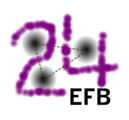Speaker
Description
Andrzej Wilczek for the BINA collaboration between
Institute of Physics, Jagiellonian University, PL-30348 Krakow, Poland
Institute of Nuclear Physics, PAS, PL-31342 Krakow, Poland
KVI-CART, University of Groningen, NL-9747 AA Groningen, The Netherlands
Institute of Physics, University of Silesia, PL-41500 Chorzow, Poland
Faculty of Physics University of Warsaw, PL-02093 Warsaw, Poland
The Space Star Anomaly (SSA) [1] is a long-lasting discrepancy between differential cross-section measured for deuteron-proton breakup at 13 MeV and the theoretical predictions. The Space Star denotes a specific configuration where momenta of the reaction products form an equilateral triangle perpendicular to the beam momentum in the centre-of-momentum frame. The analyses for the other star configurations differing from the Space Star by the inclination angle of the triangle showed that the discrepancy disappears as a function of absolute difference of the inclination angle from the perpendicular case.
So far, there is no systematic studies of SSA at intermediate energies. The single measurement at 65 MeV suggests no anomaly and increased sensitivity to relativistic effects [2]. A scan over beam energies performed for a wide set of star configurations including the Space Star can shed light on the SSA problem and also on the role of relativistic effects in description of the breakup reaction. It is interesting to see, whether the effect persists at energies of the order of 100 MeV.
The data on deuteron-proton breakup measured with the BINA experimental setup are well-suited for such an analysis. In the first stage the data collected at the deuteron beam energy of 160 MeV were analysed. The star configurations at different inclination angles in the centre-of-momentum frame were identified and simulated in order to find the feasibility of the analysis. Then, cross-sections were calculated for star configurations. The angular resolution of the central and backward part of the BINA detector is limited by the granularity of the scintillator. Therefore, simulations were performed to study the averaging of kinematic configurations over the detector elements. Finally, the cross-sections were compared with the theoretical description given by the state-of-the-art calculations and they quality of agreement will be discussed in this contribution.
[1] J. Strate et al. Nucl. Phys. A 501, 51 (1989)
[2] J. Zejma et al. Phys. Rev. C 55, 42 (1997)




